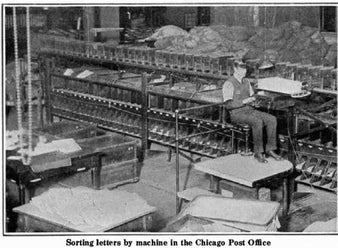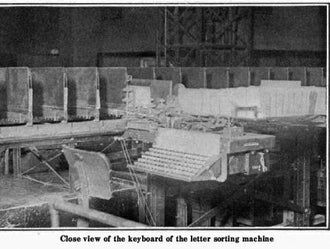This article was published in Scientific American’s former blog network and reflects the views of the author, not necessarily those of Scientific American
A certain children’s show I grew up watching had an episode featuring the post office. The host of the show got a behind-the-scenes look at what happened to all the mail once it had been delivered to the post office, and I was immediately fascinated by the immensity of letters and their ability to find the right conveyor belt in the labyrinth of machinery behind the service desks and P.O. boxes. As I came across this article from May 19th, 1917 depicting one method of sorting mail—a handy operator and a keyboard machine—my interest peaked once again.

The machine, first used in the Chicago post office, consisted of a keyboard and "carriers" attached to a conveyor belt that passed over different compartments. While the operator sat at the keyboard, the letters passed in front of him one at a time. After quickly looking at the letter, he struck a key that corresponded to the address, and the machine ushered the letter into a carrier. Each carrier had a row of triggers on its bottom that would correspond to triggers at the top of a certain compartment.
On supporting science journalism
If you're enjoying this article, consider supporting our award-winning journalism by subscribing. By purchasing a subscription you are helping to ensure the future of impactful stories about the discoveries and ideas shaping our world today.

"Once inserted in its carrier and the triggers on the latter properly set, the letter proceeds by jerks as each subsequent key is struck. It passes without recognition all the wrong compartments; but as it reaches the right one, for which the triggers holding it in place are set, it is released by the tripping of those triggers, and falls out and down into the compartment."
Pretty cool. I admit, I’m not up-to-date on how the post offices sort mail now, but I assume it’s something similar to this—minus the human element. Does anyone know how it’s progressed?

About the Author: Mary Karmelek is a production assistant for Nature Publishing Group and is currently working on Scientific American's Digital Archive Project, where she spends countless hours scouring articles and ads of decades long ago. She graduated with her MA in English from Fordham University in 2010 and currently resides in New York City. While her educational background is in gender and war trauma in modernist literature, Mary also has a keen interest in the historical and visual documentation of science, nature and medicine.